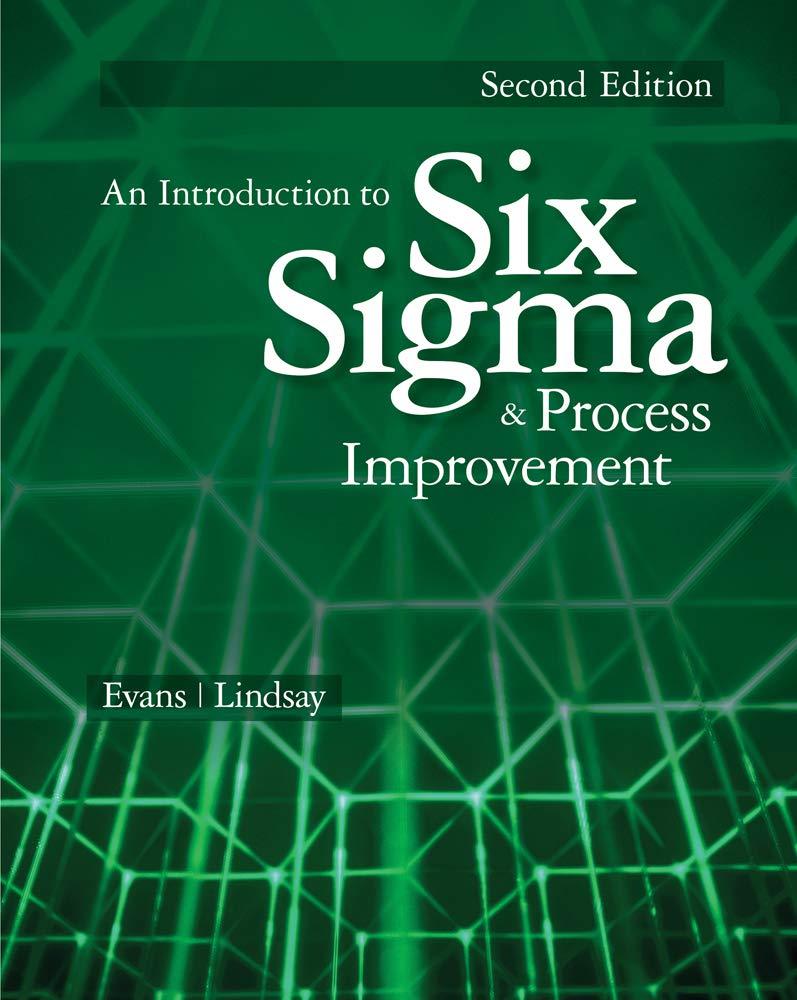The life of a watch battery is normally distributed with a mean of 950 days and standard
Question:
The life of a watch battery is normally distributed with a mean of 950 days and standard deviation of 40 days. Using the appropriate Excel functions (see Chapter 5), determine the following:
a. What fraction of batteries is expected to survive beyond 1,010 days?
b. What fraction will survive fewer than 900 days?
c. Draw a graph of the reliability function using Excel.
d. What length of warranty is needed so that no more than 10 percent of the batteries can be expected to fail during the warranty period?
| Watch Battery Life-Reliability | |||||||
| Enter data only in the shaded cells | |||||||
| This spreadsheet is designed to calculate the probability of values equal to, or less than, a desired x value, | |||||||
| given the mean and standard deviation of a normally distributed variable. It uses the cumulative normal distribution | |||||||
| Enter the mean of the distribution in shaded cell D8 and the standard deviation in shaded cell D9. below. | |||||||
| Enter the desired X-value in shaded cell D10, below. The calculated z-value and probability will be seen in D11 and D12. | |||||||
| Mean of distribution | 950 | 950 | |||||
| Std deviation of distribution | 40 | 40 | |||||
| Desired x-value | 1010 | 900 | |||||
| Calculated z-value | 1.50 | -1.25 | |||||
| Probability of x, or less | 0.93319 | 0.10565 | |||||
| (X-axis) | Probability Using | ||||||
| Desired x-values | Equivalent - Z Values | NORMS.DIST | |||||
| 790 | -4.00 | 0.00003 | |||||
| 794 | -3.90 | 0.00005 | |||||
| 798 | -3.80 | 0.00007 | |||||
| 802 | -3.70 | 0.00011 | |||||
| 806 | -3.60 | 0.00016 | |||||
| 810 | -3.50 | 0.00023 | |||||
| 814 | -3.40 | 0.00034 | |||||
| 818 | -3.30 | 0.00048 | |||||
| 822 | -3.20 | 0.00069 | |||||
| 826 | -3.10 | 0.00097 | |||||
| 830 | -3.00 | 0.00135 | |||||
| 834 | -2.90 | 0.00187 | |||||
| 838 | -2.80 | 0.00256 | |||||
| 842 | -2.70 | 0.00347 | |||||
| 846 | -2.60 | 0.00466 | |||||
| 850 | -2.50 | 0.00621 | |||||
| 854 | -2.40 | 0.00820 | |||||
| 858 | -2.30 | 0.01072 | |||||
| 862 | -2.20 | 0.01390 | |||||
| 866 | -2.10 | 0.01786 | |||||
| 870 | -2.00 | 0.02275 | |||||
| 874 | -1.90 | 0.02872 | |||||
| 878 | -1.80 | 0.03593 | |||||
| 882 | -1.70 | 0.04457 | |||||
| 886 | -1.60 | 0.05480 | |||||
| 890 | -1.50 | 0.06681 | |||||
| 894 | -1.40 | 0.08076 | |||||
| 898 | -1.30 | 0.09680 | |||||
| 902 | -1.20 | 0.11507 | |||||
| 906 | -1.10 | 0.13567 | |||||
| 910 | -1.00 | 0.15866 | |||||
| 914 | -0.90 | 0.18406 | |||||
| 918 | -0.80 | 0.21186 | |||||
| 922 | -0.70 | 0.24196 | |||||
| 926 | -0.60 | 0.27425 | |||||
| 930 | -0.50 | 0.30854 | |||||
| 934 | -0.40 | 0.34458 | |||||
| 938 | -0.30 | 0.38209 | |||||
| 942 | -0.20 | 0.42074 | |||||
| 946 | -0.10 | 0.46017 | |||||
| 950 | 0.00 | 0.50000 | |||||
| 954 | 0.10 | 0.53983 | |||||
| 958 | 0.20 | 0.57926 | |||||
| 962 | 0.30 | 0.61791 | |||||
| 966 | 0.40 | 0.65542 | |||||
| 970 | 0.50 | 0.69146 | |||||
| 974 | 0.60 | 0.72575 | |||||
| 978 | 0.70 | 0.75804 | |||||
| 982 | 0.80 | 0.78814 | |||||
| 986 | 0.90 | 0.81594 | |||||
| 990 | 1.00 | 0.84134 | |||||
| 994 | 1.10 | 0.86433 | |||||
| 998 | 1.20 | 0.88493 | |||||
| 1002 | 1.30 | 0.90320 | |||||
| 1006 | 1.40 | 0.91924 | |||||
| 1010 | 1.50 | 0.93319 | |||||
| 1014 | 1.60 | 0.94520 | |||||
| 1018 | 1.70 | 0.95543 | |||||
| 1022 | 1.80 | 0.96407 | |||||
| 1026 | 1.90 | 0.97128 | |||||
| 1030 | 2.00 | 0.97725 | |||||
| 1034 | 2.10 | 0.98214 | |||||
| 1038 | 2.20 | 0.98610 | |||||
| 1042 | 2.30 | 0.98928 | |||||
| 1046 | 2.40 | 0.99180 | |||||
| 1050 | 2.50 | 0.99379 |
Fantastic news! We've Found the answer you've been seeking!
Step by Step Answer:
Related Book For

An Introduction To Six Sigma And Process ImprovementISBN: 9781133604587 2nd Edition Authors: James R. Evans, William M. Lindsay
Question Posted:
| ||||





